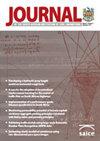A comparison of traditional road safety assessment methods and the newly developed 'road safety deserts' approach
IF 0.4
4区 工程技术
Q4 ENGINEERING, CIVIL
Journal of the South African Institution of Civil Engineering
Pub Date : 2024-04-02
DOI:10.17159/2309-8775/2024/v66n1a3
引用次数: 0
Abstract
Road fatalities were labelled a pandemic as early as 1973 (BMJ 1973). The number of road fatalities reached 1.35 million in 2016. Currently over 3 500 people perish every day on the world's roads. South Africa has one of the highest road fatality rates in the world, with a fatality rate of 25.9 deaths per 100 000 population (WHO 2018). In order to understand and improve the road safety situation of a region, effective road safety assessments must be carried out. This paper presents a comparison of four different road safety assessment approaches, both traditional and novel, and serves as a proof of concept for the 'road safety desert' methodology, a new technique adapted from the 'transit desert' concept. This new approach to road safety assessment explores the possibility of geo-coded supply and demand comparisons to identify 'road safety deserts' - areas that have a comparatively higher road safety risk. This paper shows that there are several unique and effective ways to assess road safety, and that each approach incorporates different characteristics within their methodologies. It is recommended that road safety analysis is conducted using a multitude of methods, so as to improve understanding and intervention selection.传统道路安全评估方法与新开发的 "道路安全沙漠 "方法的比较
公路死亡事故早在 1973 年就被称为大流行病(《英国医学杂志》,1973 年)。2016 年,道路死亡人数达到 135 万。目前,全世界每天有超过 3500 人死在路上。南非是世界上道路死亡率最高的国家之一,每 10 万人中有 25.9 人死亡(世界卫生组织,2018 年)。为了了解和改善一个地区的道路安全状况,必须开展有效的道路安全评估。本文比较了四种不同的道路安全评估方法,既有传统的,也有新颖的,并作为 "道路安全沙漠 "方法的概念验证,这是一种从 "过境沙漠 "概念改编而来的新技术。这种新的道路安全评估方法探索了地理编码供需比较的可能性,以确定 "道路安全沙漠"--道路安全风险相对较高的地区。本文表明,有几种独特而有效的道路安全评估方法,每种方法都在其方法论中融入了不同的特点。建议使用多种方法进行道路安全分析,以增进理解和选择干预措施。
本文章由计算机程序翻译,如有差异,请以英文原文为准。
求助全文
约1分钟内获得全文
求助全文
来源期刊
CiteScore
0.70
自引率
25.00%
发文量
19
审稿时长
>12 weeks
期刊介绍:
The Journal of the South African Institution of Civil Engineering publishes peer reviewed papers on all aspects of Civil Engineering relevant to Africa. It is an open access, ISI accredited journal, providing authoritative information not only on current developments, but also – through its back issues – giving access to data on established practices and the construction of existing infrastructure. It is published quarterly and is controlled by a Journal Editorial Panel.
The forerunner of the South African Institution of Civil Engineering was established in 1903 as a learned society aiming to develop technology and to share knowledge for the development of the day. The minutes of the proceedings of the then Cape Society of Civil Engineers mainly contained technical papers presented at the Society''s meetings. Since then, and throughout its long history, during which time it has undergone several name changes, the organisation has continued to publish technical papers in its monthly publication (magazine), until 1993 when it created a separate journal for the publication of technical papers.

 求助内容:
求助内容: 应助结果提醒方式:
应助结果提醒方式:


